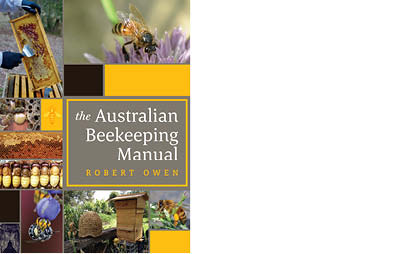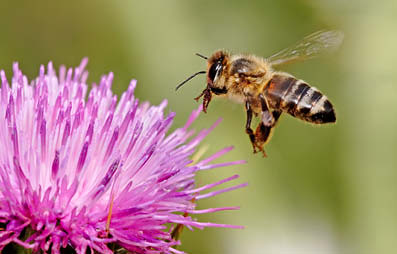Robert Owen, author of the recently released book The Australian Beekeeping Manual – written specifically for Australian beekeepers – shares tips on how to create a bee-friendly garden, whether you’re a beekeeper, or just want to encourage bees to visit your garden.
What is the ideal garden for a home beekeeper to plant, especially the gardener whose primary focus is edible produce rather than flowers?
While it’s difficult to achieve a bee-friendly garden relying solely on vegetables, numerous flowering shrubs and trees will provide food for you and good forage for your bees. So think about what you like to eat and then do some research to find out what will thrive in your region.
Citrus
Citrus species are attractive to bees and make wonderful garden specimens with their glossy leaves and clusters of sweet-smelling flowers. Imagine the possibilities in your kitchen when you grow your own lemon, orange, grapefruit, mandarin and limes. Citrus species demand sunshine and free-draining soils, otherwise they may develop collar rot and other diseases. If your soil is heavy clay, consider a raised bed to aid drainage. Consult your nursery if you live in cooler parts of the country about cold-tolerant varieties.
Blueberries
The blueberry is another great choice for the home gardener. Numerous types are available to suit a variety of conditions, and they come in both tall-growing and low bush forms. Beautiful bee-attracting flowers are followed by delicious nutrient-loaded fruit and then red-hued autumn foliage. While they need an acid soil, they do well in large containers if your soil is too alkaline.
Pineapple guava
Another option is to plant a flowering windbreak or hedge to hide an ugly fence or to protect your tall vegetables from wind damage. The pineapple guava (Feijoa sellowiana) makes a lovely evergreen hedge with its shinny green leaves with their silver-felt undersides. Striking red flowers are followed by delicious fruit. It clips well and is tolerant of a wide variety of conditions.
Lemon verbena hedge
Or consider a lemon verbena hedge: very hardy, fragrant and the leaves make a delightful fresh tea.

Add flowers to rows of vegetables
A plant that produces no flowers offers no bee forage.
Even the strictest edible gardener should consider interrupting rows of vegetables with well-placed flowering companion plants such as calendula and nasturtiums. These can aid the growth of many vegetables and some will confuse and deter the pests attracted to the “come and eat me” landing strip offered by neat rows of a plants. Seek out the many publications available on companion planting: chosen wisely, these plants will offer food for your bees and support to you as a gardener.
Herbs for your health, and that of your bees
If you like the formal parterre look for your vegetables or herbs, use low-growing flowering herbs such as garlic chives or curly parsley (Petroselinum crispum) as an edging. Low-growing lavender species (L. stoechas) or cotton lavender (Santolina chamaecyparissus) also look very attractive. Allow some of your vegetables to flower, as this will attract bees and butterflies and also give you seed for the following year.
Herbs deserve a place in every garden: a sunny spot, a few human and bee favourites such as oregano, basil, lavender, rosemary, thyme, garlic, chives, lemon balm, borage and parsley, and you’re off to a good start for both your health, and that of your bees. Grow several plants of each type, and learn to pinch your herbs for use in your kitchen. This produces further branched stems and ensures more flowers on those plants you leave to flower for your bees.

Heirloom vegetables and fruit
Consider growing heritage or heirloom vegetables and fruits as they provide both flavour and abundance, with the added advantage that they’ve usually evolved over time to be very attractive to the bees they need for pollination. Again, work out what will grow in the conditions your garden can offer, ensure the soil is well prepared with compost and start planting: you can make your patch productive and nutritious for both you and your bees and at the same time add to the diversity of the overall forage available in your community.
Planting possibilities are endless so do a little research and find out which fruits that you like to eat will grow in your garden conditions. The vast majority will rely on your bees for pollination and even those that do not – such as most olive species, which get by on wind pollination – will still attract your bees, who will forage on them and further increase fruit bearing.
What can gardeners who don’t keep bees do to encourage bee populations?
Plant anything that flowers and is attractive to bees, provided the plants will thrive in the conditions your garden offers. Give preference to species that repeat flower or, alternatively, flower for reasonably long periods.
Choose plants with simple open blooms rather than those with a multitude of cluttered petals as this makes it difficult for the bee to gain access to the nectar-rich part of the flower. Hybrid varieties of flowers with a jumble of petals are often sterile and offer little, if anything, for the foraging bee.
Multi bloomed plants (many small flowers on one stem) offer energy-efficient forage and are bee favourites. A few varied examples include buddleia, Californian lilac, lavender, rosemary (including native types), garlic, many herbs, Grevillia, bottle brush, hebe, and sedum.
Remember: a plant that produces no flowers offers no bee forage.
If you’re attracted to plants with a certain structural form, such as the ubiquitous evergreen box hedging or Mondo grass, search out a similar flowering substitute. Dwarf hebe can be trimmed after flowering and kept compact. Various liriope species have a low strappy look similar to Mondo grass, but with flowers.
For gardeners with little time, planting lavender and rosemary in groups or as low hedges cannot fail to attract large numbers of visiting bees.
Finally if you’re keen to attract native bees as well as the European honeybee, take some time to learn how you can provide the habitat attractive to them in your garden. This is not difficult and it’s an absolute thrill to see lesser-known bees buzzing around your garden in the company of visiting honey bees.




